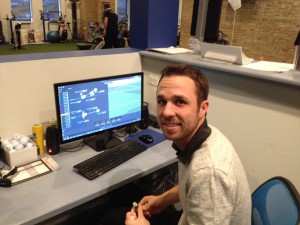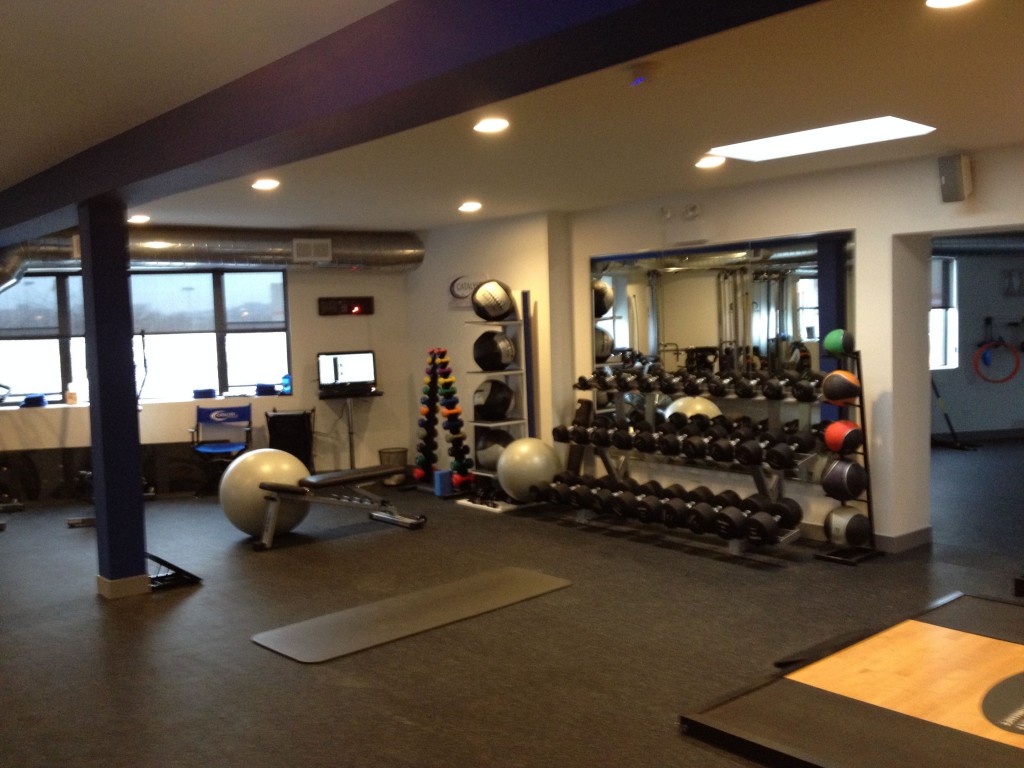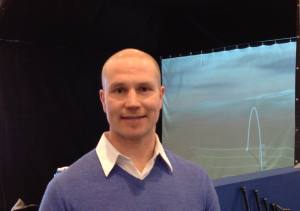Tommy Asuma, Catalyst’s head athletic trainer, took some more measurements, chronicling my limited flexibility, particularly in my hips. Then we started in on the prescribed drills.
One involved elevating my heels on a half-foam-roller (I used a medium-sized phone book at home before buying my own roller) and try to touch my toes. Eight reps. Then I elevate my toes for more eight more reps. Finally, I do the same drill with my feet flat on the floor.
“You’ll be touching your toes in a couple of weeks,’’ Tommy says.
The flexibility exercises take 30 to 40 minutes. The workout is not overwhelming, but I am sweating a tad from straining to improve my range of motion.
Then it’s on to the more golf-specific session with golf pro Joe Sheren. Even with Joe, there are more flexibility/range-of-motion drills before I pick up a golf club.
Then we go over portions of the 20-minute evaluation video Joe has put together. The key point: I have a wide-open path, which is offset (on a good shot) by a wide-open face angle.
That produces “a glancing blow,’’ as Joe calls it. This is not news to me. For years, I have been overcoming my faults with flailing arms and sufficient hand-eye coordination to keep the ball in play.
That’s becoming more and more problematic. With a drives creeping over 200 yards and pitching wedges that went 100 yards, I could grind a bit, especially when I was chipping and putting. With even those modest driver-wedge yardages in decline, that’s less and less true.
“Give us three months,’’ Joe said, “and we can definitely give you more distance.’’
“Sign me up,’’ I said.
&&&&&&&&&&&&&&&&&&&&&&&&&&&&&&&&
“Swing as hard as you can!’’ my golf instructor, Joe Sheren, said. He said it again and again.
I am not a violent person, but that’s not the reason I fail to swing out of my shoes. I tend to be methodical because life has taught me: My best golf shots occur when I manage to put the club in the best position at the top of the backswing, and follow that with the coordination and timing to put the clubface on ball reasonably well.
Because I don’t hit it far, I need to hit it straight, so I tend to steer the ball rather than swing through it. And because my body has difficulty getting to the left side for a variety of physiological reasons, I sometimes wonder if I can swing as hard as I can, no matter what I try to do.
When I swing as hard as I can, bad things happen. I hit really low screamers left, and right. Or I simply dribble the ball, barely hitting it at all.
That said, I know where Joe is going with this. And I am trying to swing as hard as I can, when my mind can convince my body it’s a really good idea at this point.
Even with just the hint of getting the club in the right place at the top of the backswing, I am able to swing much harder—without feeling like I’m going to hurl myself down the fairway on the follow-through.
The flexibility and coordination drills that trainer Tommy Asuma has given me are starting to help. As he predicted, I am perilously close to touching my toes. My hips are sore—a good sore—from all manner of drills aimed at giving me improved lower-body mobility, so that I can make a turn.
But swinging as hard as I can is an odd sensation. The one place where I approach swinging as hard as I can is with a driver. The longer shaft makes it easier to overcome my lack of a quality turn—and my 12-degree TaylorMade Burner is like an old friend. I trust it to not let me down when I over-swing.
Swinging hard during a no-wrist, short-backswing drill designed to make me use my lower body is a different matter. We are using a 9-iron, a club that has gone from being a 125-yard dead-aim friend to a dangerous subversive. When I swing hard with a 9-iron, disaster lurks. In a pinch, I’d rather hit a half 7-iron, and I often do—even though I hate doing that.
For years, I have stopped my follow-through because I have lacked the flexibility to make that move. I also have found that my “steering’’ move helps me hit the ball straight, which is essential for someone who doesn’t hit it long.
These habits must be broken, though.

I’m sure golf pro Joe Sheren has faced bigger challenges than fixing my swing. But I’m not going to ask him to confirm that.
Joe gives me a step drill. I set up in a normal stance, then bring my left foot back to my right and pause. When I start my backswing, I am supposed to step forward.
Having practiced this little drill at home, I am comfortable with it. I am pretty much able to swing as hard as I can. I even am able to put the beginnings of a lower-body turn into it.
I actually strike the ball better, and get a better result, when I use the step-stride move, which has as a lot in common with a baseball hitter’s stride.
Don’t know how good that would look at the country club, though—or even the muni.
When I remove the step portion, it’s an uneven struggle. But I am going to keep trying.
As frustrating and difficult as this is, there’s going to be a lot of golf to play this year.


